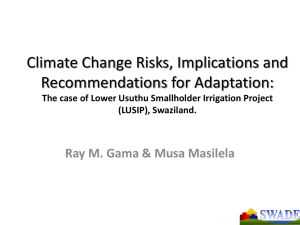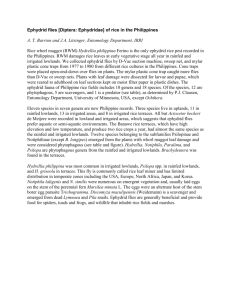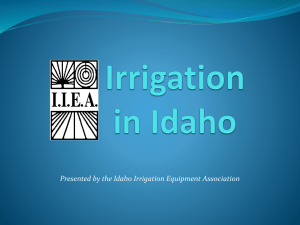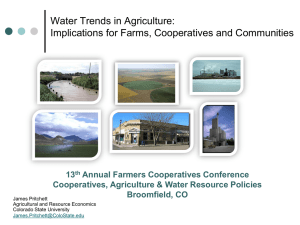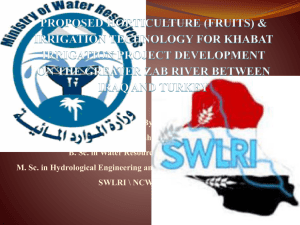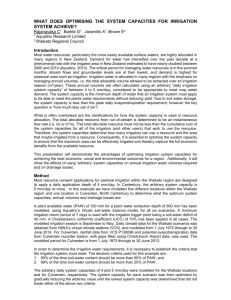Measuring Results of Irrigation Development: RIPPA Approach
advertisement
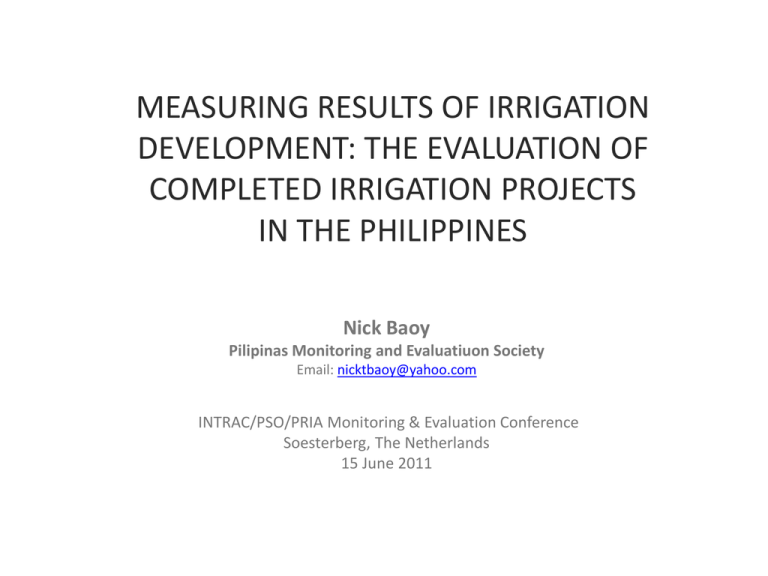
MEASURING RESULTS OF IRRIGATION DEVELOPMENT: THE EVALUATION OF COMPLETED IRRIGATION PROJECTS IN THE PHILIPPINES Nick Baoy Pilipinas Monitoring and Evaluatiuon Society Email: nicktbaoy@yahoo.com INTRAC/PSO/PRIA Monitoring & Evaluation Conference Soesterberg, The Netherlands 15 June 2011 PHILIPPINE AGRICULTURE SECTOR: A QUICK OVERVIEW • Total agricultural area : 9.6 million ha (32% of total land area) • Share of agriculture in GDP: 18% • Share of agriculture in total employment: 35% • GVA share of crops in agriculture: 50% • Total rice production in 2010: 15.8 million mt • Total rice imports in 2010: 1.8 million mt PHILIPPINE IRRIGATION DEVELOPMENT: QUICK FACTS • Total irrigation potential: 3.1 million ha (32% of total arable land) • Total area served by irrigation: 1.4 million ha • Share in irrigated area by type of system: – National systems: 49% – Communal systems: 39% – Private systems: 12% • % of rice produced in irrigated areas: 76% IRRIGATION PROJECTS EVALUATED Project A B Total Area, ha A - CMIPP 16,879 B - TGISRP 3,218 C - PDDP 7,836 D - BHIP-1 4,140 E - BHIP-2 5,300 F - BRISRIP 11,954 C D F E SIGNIFICANCE OF EVALUATED PROJECTS % share in total irrigated area % share in total rice production A - CMIPP 2.5 0.78 B - TGISRP 0.5 0.15 C - PDDP 1.2 0.11 D - BHIP-1 0.6 0.15 E - BHIP-2 0.8 0.12 F – BRISRIP 1.8 0.47 Total 7.4 1.8 Project OBJECTIVES OF EVALUATION • Examine the performance of six completed projects funded by yen loan • Identify issues that need to be addressed to improve project performance • Suggest measures to enhance project effectiveness and sustainability KEY EVALUATION QUESTIONS • Were the projects able to expand the irrigated rice area? • Were the projects able to increase rice production in target areas? • Did the projects contribute to the increase in farmers’ income? RAPID IRRIGATION PROJECT PERFORMANCE ASSESSMENT (RIPPA) FRAMEWORK Planning Phase Assessment Phase Action Planning Phase Collect & review project documents Consult with project stakeholders Present findings to project stakeholders Clarify project results framework Implement assessment plan Formulate action plan Formulate rapid assessment plan Analyze data & assess performance Prepare RIPPA report TYPICAL RESULTS CHAIN OF IRRIGATION PROJECTS INPUTS • Labor • Equipment • Technical assistance ACTIVITIES OUTPUTS Output • Construction/ • Operable rehabilitation of irrig facilities • Institutional development • Supply of equipment irrig system • Functional water users groups • Improved system O&M OUTCOME Outcome • Increased irrigated area • Increased rice production • Improved irrigation service IMPACT • Increased farm income • Improved living standards • Self-sufficiency in rice SOME PARTICIPATORY TOOLS USED IN RIPPA • Mapping • Transect walk • Interviews (focused, group, key informant) • Structured problem/solution analysis • Participatory action planning workshop • Triangulation and cross-checking KEY EVALUATION FINDINGS • The projects succeeded in expanding the irrigated rice area. • The projects increased average rice yields in target areas. • The projects contributed to the increase in farmers’ income. • Due to operational issues, most projects failed to achieve cropping intensity targets. PROBLEM TREE: BHIP-I ISF collection target is not achieved Cropping intensity target is not achieved Institutional issues Target irrigated area (4,740 ha) not achieved Insufficient water at Malinao dam Inefficient water distribution Water conveyance losses Some leveled lands remain un-irrigated Low amount of rainfall Non-compliance with CCPP Unlined/very long MFDs Incomplete MFDs/SFDs Dam not reservoir type Defective WD structures Damaged canal structures Insufficient water in DS Degradation of watershed Illegal turn-outs Lack of SFDs Lands higher than canal Weak IA policy enforcement Illegal checks/ impoundments PROBLEM TREE: BRISRIP ISF collection target is not achieved Cropping intensity target is not achieved Institutional issues Target irrigated area (11,954 ha) not achieved Low river discharge Water can’t reach some areas Degradation of watershed Lack of terminal facilities Low rainfall (e.g. El Nino) ROW problems Inefficiencies in water mgt Non-compliance to WDD schedule Farmers unable to build ditches Excessive water offtake/diversion Weak IA policy enforcement Flooding in the downstream Sugarcane areas are excluded from LIPA Lack of drainage outlets Sugar lands are not irrigated Siltation of drainage canal Sugarcane farmers are not IA members Flooding during high tides No control over crop conversion ACTION PLAN: BRISRIP ISSUE RECOMMENDED ACTIONS (1) Low river discharge arising from degraded watershed & low rainfall • Coordinate with PENRO re Bago River Watershed Mgt • Promote Water Saving Technology (WST) • Continuous review of CCPP/WDD (2) Water cannot reach some areas due to lack of terminal facilities and inefficiencies in water management • • • • • (3) Flooding in downstream due to lack of drainage outlets, siltation of drainage channels & tidal flows • Construct additional drainage outlets/channels • De-silt clogged drainage channels • Build pumping station/check structures for seawater (4) Sugarcane areas are excluded from LIPA as farmers do not avail of irrigation service during WS • Include sugarcane lands in LIPA even if irrigated only during DS • Review ISF collection policy for lands served by project facilities but not availing of irrigation service Assist IAs/TSAGs in constructing on-farm facilities Settle ROW problems Strengthen IA policy enforcement Strictly implement WDD schedule Promote WST ACTION PLAN TEMPLATE Issue/Problem 1 2 3 4 5 6 7 8 9 10 Planned Solution/ Countermeasure Actions Taken by Concerned Unit in NIA Actions Planned in 2011 Actions Planned up to 2012 & beyond Estimated Budget Requirement Budget Source and Status Expected Results (e.g. Hectares Developed/Restored ) SOME INSIGHTS ON RIPPA • Quick structured method for assessing project outcomes and identifying post-project issues which could feed into periodic and more formal evaluations • Commitment among stakeholders in addressing project issues is promoted by participatory evaluation approaches • Attribution of observed changes/results becomes a challenge in evaluating projects that have long been completed. Thank you! Dank u wel! Salamat po!


